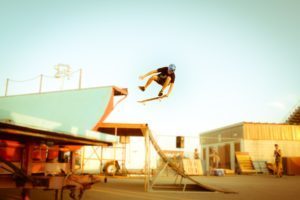
Water, as well as land-based extreme sports, are quite popular here in Florida. To name a few, we have: Skateboarding, Surfing, Kite Boarding, Wakeboarding, Motocross, Mountain Biking, Parkour, and Adventure Racing.
Each has its own unique injuries and risks. It’s apparent that the risk for injury in extreme sports is high. However, since these sports don’t tend to have a governing body and because they are usually individual as opposed to group sports, injury types and rates are not as well tracked. However, the exposure to significant injury matches and likely exceeds that of ordinary team sports.
By their very nature, extreme sports push athletes to expose themselves to take greater risks – not necessarily for points on a scoreboard, but for the excitement and thrill of pulling off a unique and challenging trick/maneuver. The greater the risk, the greater the reward. This risk-reward relationship can result in traumatic injuries from a fall, or repetitive overuse injuries from the athlete pushing the limits of their body.
In this article, we’ll take a look at skateboarding. The thrill and injury of this extreme sport is one with which I’m personally familiar!
Skateboarding
Skating started in the late 1950’s, created mostly by California surfers who wanted something similar to surfing when there were no waves. Hence, wooden boards on roller skate wheels, brought about the invention of the skateboard and “sidewalk” surfers.
Of course, it evolved and continues to evolve as equipment and design improves. In the 1960’s the wheels were made of clay and were unreliable, but in the 1970’s the transition to urethane wheels allowed for a much smoother ride along with the use of different surfaces like pools, banks, and ditches. Around the same time, the Ollie was popularized by Alan Gelfand. The Ollie was a maneuver or trick that allowed the rider to do aerial tricks, bringing the board and wheels off the ground. Since then, equipment and skatepark designs have continued to improve, allowing skateboarders to perfect and continually invent new tricks/maneuvers.
There are really two categories within this sport:
“Street”- riding and performing tricks on all kinds of different surfaces including flat ground, launch ramps and pyramids, rails and stairs, etc.
“Vert” – This is performed on a large u-shaped ramp, in which aerial tricks can be performed, as well as tricks on the coping along the top of the vert ramp.
Skateboarding Injuries:
The most common injuries for skateboarders and sprains/strains, fractures, contusions, and lacerations. These tend to occur to the wrists and forearms from falling with an outstretched hand. Other common regions of sprains/strains, fractures, contusions, and lacerations are feet, ankles, and lower legs, from landing awkwardly. Vert ramp skaters tend to have higher rates of knee injury from falling and sliding down the ramp with their knees fully flexed.
Injury Prevention is Key:
You will take many falls while skateboarding, usually in the direction you were riding. Since falling on outstretched hands is a major cause of injury for the wrists, forearms, and shoulders – learning and practicing falling techniques can be quite useful. Martial Arts have many falling techniques that can be learned and practiced, like rolling out of a fall, for example.
Purchase and maintain a good quality skateboard. Check your trucks, nuts, and bolts to make sure everything is in working condition. For example, loose trucks can lead to wheel bite. Small wheels can get caught on the smallest of pebbles and throw you forward.
Safety equipment will help prevent serious injury, the most important, being a helmet to protect yourself from head injury. If you’re skating vert, you’ll want knee pads for sure. Make sure the equipment is well fitted.
Become familiar with the general flow and etiquette at a skatepark. This will go a long way to avoid colliding with other skaters.
Skills come with a lot of practice and experience, and it’s easy to get hurt when you’re attempting a trick way beyond your skill set. Be patient.
At CMF, we offer an advanced approach when it comes to musculoskeletal pain and injury. Learn more at our website www.cmfchiropractic.com, and give us a call at (561) 318-8070 to get started.
Have fun and skate safe!
References:
Hyde and Gengenbach. “Conservative Management of Sports Injuries – Second Edition.”
Siljeg, Sky. teacher.scholastic.com “Skate Safety – A Crash Course.”
©CenterForMusculoskeletalFunction2017










